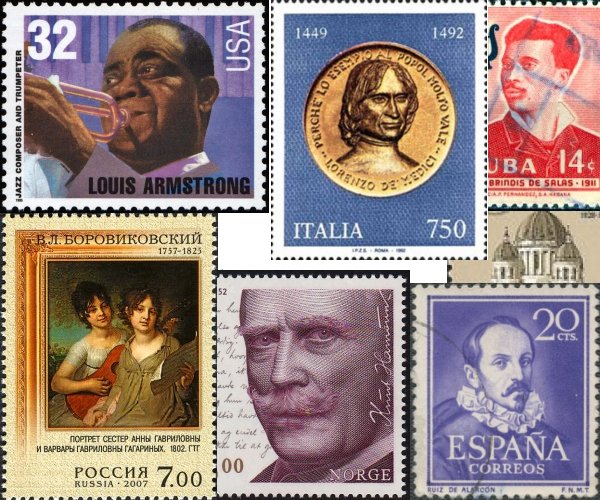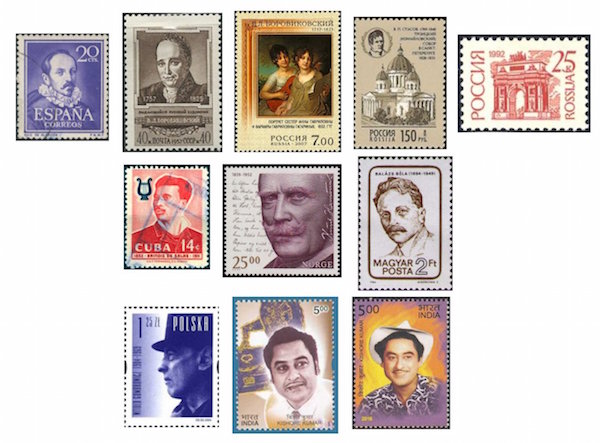The Arts on Stamps of the World — August 4
An Arts Fuse regular feature: the arts on stamps of the world.

By Doug Briscoe
I am astonished to find not a single stamp honoring Percy Bysshe Shelley (4 August 1792 – 8 July 1822).
But there are several for Satchmo, Louis Armstrong (August 4, 1901 – July 6, 1971), whom many see as the greatest jazz man ever. He was born in poverty in New Orleans and always maintained that his birthday was the Fourth of July. Only research as recent as the 1980s showed that he was actually born on the Fourth of August. Besides the U.S. stamp from 1995, I found examples from Grenada, Senegal, France, Niger, and Dominica.
Juan Ruiz de Alarcón, who died on this date in 1639, was one of the first playwrights born in the New World. His parents had come to Mexico in 1535, and Alarcón first saw light of day in the south of the country around the year 1581. A redhead and a hunchback, he was often the butt of ridicule. In 1600 he traveled to Spain to study law, returned in 1608, but was back in the old country from 1611 to the end of his life. It seems he wrote his first plays just to earn a little money. He was a perfectionist who took great pains with the language and structure of his two dozen plays. Twenty of these, including his masterpiece, La verdad sospechosa (Suspect Truth), appeared in print in two volumes (1628 and 1634) during his lifetime.
Next we turn to two late-eighteenth-, early nineteenth-century Russian artists. Vladimir Borovikovsky (August 4 [July 24 O.S.], 1757 – April 18 [April 6, O.S.], 1825) was in his prime the preeminent portrait painter in Russia. Born Volodymyr Borovyk in the Ukraine, he took to painting icons for local churches. It happened that Catherine the Great was to pass through the region on her way to the Crimea, and Borovikovsky had a friend who was put in charge of arranging accommodations for the empress. He suggested that Borovikovsky prepare a couple of paintings for her rooms, and she so liked the pieces that she asked him to come to Saint Petersburg. He lived there from 1788, producing upwards of 500 portraits. He neither attended nor taught at the Imperial Academy of Arts, but took private lessons and in later years provided tuition in his home for such artists as Alexey Venetsianov and Ivan Bugaevsky-Blagodatny, who painted the only known portrait of Borovikovsky, seen on the Soviet stamp of 1957. Toward the end of his life he came full circle and turned again to the production of icons. The recent Russian stamp of 2007 shows his portrait of the Princesses Anna and Varvara Gavrilovna (1802).
Borovikovsky’s contemporary Vasily Petrovich Stasov (4 August 1769 – 5 September 1848) came from a different background altogether. Born in Moscow, he traveled in France and Italy and was for a time a docent at the St Luke Academy in Rome. Back in Russia from 1811, he built Trinity Cathedral (1828-35, shown on the brown stamp) and Transfiguration Cathedral (1825-29), both in Saint Petersburg. (Trinity suffered a bad fire in 2006; restoration was completed in 2010.) His other works include the Alexander Nevsky Memorial Church in Potsdam, the reconstruction of the Presidential Palace in Vilnius (1824-34), triumphal gates for both St Petersburg and Moscow (see the red stamp), and the Church of the Tithes in Kiev (1828, destroyed by the Soviets in 1935). He was the father of the important critic Vladimir Stasov.

Afro-Cuban concert violinist Claudio Brindis de Salas Garrido (4 August 1852 – 1 June 1911) was the son of a violinist and bandleader. He first performed publicly in Havana in 1863, in a concert in which Ignacio Cervantes, whose birthday we just noted on July 31st, also took part. Brindis de Salas went on to study at the Paris Conservatory, where he took first prize in 1871, then toured Italy, including at La Scala. In 1875 he returned to the Caribbean and became director of the Haiti Conservatory, continuing to give concerts all throughout the Americas as well as in St Petersburg, Russia, and in Spain. He received the Légion d’Honneur and was made chamber musician to the Kaiser, who gave him the title of baron. (Brindis de Salas married a German woman and became a German citizen.) Despite his great success—at one time he owned and played a Stradivarius—he died in poverty from tuberculosis in Buenos Aires. In 1930 his remains were reinterred in Havana.
The reputation of the undeniably great Norwegian novelist Knut Hamsun (August 4, 1859 – February 19, 1952) was tarnished by his support for World War II era Germany and his admiration for Hitler. After the war, an old man of 87 or 88, he was tried for treason and compelled to pay a massive civil fine. His greatness as a pioneer of psychological fiction and stream of consciousness, said to have influenced figures as wide-ranging as Thomas Mann, Kafka, Gorky, Stefan Zweig, Henry Miller, Hesse, and Hemingway, earned him the Nobel Prize in Literature in 1920. His novel Growth of the Soil (Markens Grøde, 1917) was particularly cited on that occasion. Hamsun was the subject of an eponymous biopic made in 1996, in which Max von Sydow played the title role. Some of Hansun’s work was translated by Isaac Bashevis Singer, who called Hamsun “the father of the modern school of literature in his every aspect.”
Hungarian poet Béla Balázs (BAY-la BALL-ahsh; 1884 – 17 May 1949), born Herbert Bauer to German-Jewish parents, was the librettist for Bartók’s only opera, Bluebeard’s Castle, and also provided the scenario for the same composer’s only ballet The Wooden Prince. (The Bluebeard scenario was originally intended for Balázs’s roommate Zoltán Kodály, who set three of Balázs’s poems in his set of songs, Op. 5.) While in Vienna he worked as a film critic and wrote the screenplays for G. W. Pabst’s film of Die Dreigroschenoper (1931) and Leni Riefenstahl’s Das Blaue Licht (1932, from which his name and that of his co-writer Carl Meyer were removed). From 1933 to 1945 he lived in the Soviet Union, thereafter residing in Budapest, where he provided the screenplay for one of his most celebrated films, Somewhere in Europe (It Happened in Europe, 1947).

Polish writer Witold Gombrowicz (August 4, 1904 – July 24, 1969) tried his hand at a couple of novels that he abandoned before turning to short stories, but these remained unpublished for many years. In 1939 he quite luckily decided to take a cruise to Argentina and was there when the war broke out. He reported to the Polish legation but was found unfit for duty, so he remained in Argentina not only for the rest of the war but until 1963. Thus it was that his first novel was published in Spanish (his own translation, but with assistance from his friend the Cuban writer Virgilio Piñera). After a fashion his work began to appear in European publications, and by the 1960s his fiction and plays had made a name for him, but his worth as a writer was not fully recognized until after his death. His lived his final years in France. Gombrowicz’s work (I haven’t read any of it) is said to be psychological and anti-nationalist, with a tendency to paradox and the absurd. His greatest work is held to be the diaries he published between 1953 and 1969.
Kishore Kumar (4 August 1929 – 13 October 1987) wore a variety of hats in Indian filmmaking: primarily a singer/actor, he branched out into writing lyrics, composing, producing, directing, and screenwriting. Born Abhas Kumar Ganguly, he was introduced to film by his actor brother Ashok Kumar, who was already a star when Kishore appeared with him in his first movie. He sang not only in Hindi but in at least nine other languages of India.
A graduate of the University of Massachusetts with a B.A. in English, Doug Briscoe worked in Boston classical music radio, at WCRB, WGBH, and WBUR, for about 25 years, beginning in 1977. He has the curious distinction of having succeeded Robert J. Lurtsema twice, first as host of WGBH’s weekday morning classical music program in 1993, then as host of the weekend program when Robert J.’s health failed in 2000. Doug also wrote liner notes for several of the late Gunther Schuller’s GM Recordings releases as well as program notes for the Boston Classical Orchestra. For the past few years he’s been posting a Facebook “blog” of classical music on stamps of the world, which has now been expanded to encompass all the arts for The Arts Fuse.

